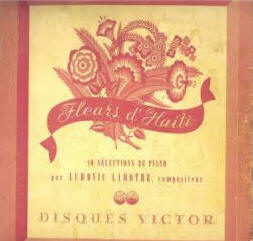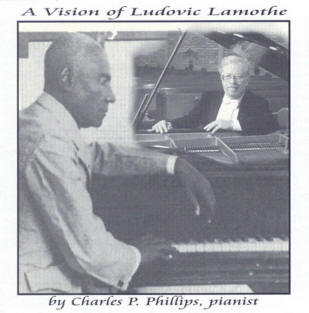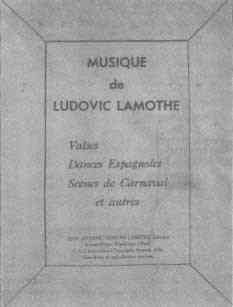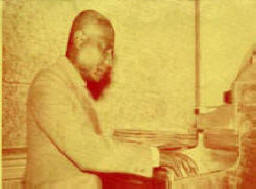Home
Blog
Composers
Musicians
Black History
Audio
About Us
Links
Composers:
Adams, H. Leslie
Akpabot, Samuel Ekpe
Alberga, Eleanor
Bonds, Margaret Allison
Brouwer, Leo
Burleigh, Henry Thacker
Coleridge-Taylor, Samuel
Cunningham, Arthur
Dawson, William Levi
Dede, Edmund
Dett, R. Nathaniel
Elie, Justin
Ellington, Edward K. "Duke"
Euba, Akin
Garcia, José Mauricio Nunes
Hailstork, Adolphus C.
Holland, Justin
Jeanty, Occide
Johnson, James Price
Joplin, Scott
Kay, Ulysses Simpson
Khumalo, Mzilikazi
Lambert, Charles Lucien, Sr.
Lambert, Lucien-Leon G., Jr.
Lamothe, Ludovic
Leon, Tania
Moerane, Michael Mosoeu
Perkinson, Coleridge-Taylor
Pradel, Alain Pierre
Price, Florence Beatrice Smith
Racine, Julio
Roldan, Amadeo
Saint-Georges, Le Chevalier de
Sancho, Ignatius
Smith, Hale
Smith, Irene Britton
Sowande, Fela
Still, William Grant
Walker, George Theophilus
White, José Silvestre
Williams. Julius Penson
AfriClassical Blog
Companion to AfriClassical.com
Guest Book
William J. Zick, Webmaster,
wzick@ameritech.net
©
Copyright 2006 - 2022
William J. Zick
All rights reserved for all content of AfriClassical.com

Fleurs d`Haiti, 10 Selections de
Piano par Ludovic Lamothe Compositeur; Disques Victor

« A Vision of Ludovic
Lamothe »
by Charles P. Phillips, pianist
IFA Music Records (2001)

Music of The Haitian Masters
La dangereuse et al.
Jean E. Saint-Eloi, Midi guitar
IFA Music Records 256 (1999)
CD & MP3 Available
Amazon.com
www.amazon.com/
Music-The-Haitian-Masters-Vol-1/dp/B0014BZHKM
ArkivMusic.com
www.arkivmusic.com/
classical/Name/Jusin-Elie/Composer/224493-1
CDBaby.com
www.cdbaby.com/cd/
sainteloi
iTunes.com
https://itunes.apple.com/
us/album/music-haitian-masters-vol.1/id14492536

Musique de Ludovic Lamothe
(Music of Ludovic Lamothe)
|
Home ->
Composers -> Lamothe, Ludovic
Français
Audio Sample:
MSR Classics MS 1242 (2008); William Chapman
Nyaho, piano
La Dangereuse
1 Birth
Ludovic
Lamothe is one of Haiti's most renowned classical composers. He
was born in Port-au-Prince, his country's capital, on May 12,
1882. Both of his parents were pianists, and Ludovic took his
first piano lessons from his mother.
Vodou Nation: Haitian
Art Music And Cultural Nationalism,
written by Michael Largey, and published by The University of
Chicago Press (2006), is an important reference source for his
music.
2 Parents
Lamothe's father and grandfather were pianists, Michael Largey
tells us, and his mother was an accomplished poet:
|
He was the son of
Virginie Sampeur (1839-1919), a highly regarded poet.
Before her marriage to Ludovic's father, Sampeur was
married to poet Oswald Durand, author of the Haitian
Kreyol poem “Choucoune.” Lamothe's father, Tacite
Lamothe, was a pianist, and his grandfather, Joseph
Lamothe, was also a proficient instrumentalist. |
3 Music
Studies
Dominique-René de Lerma is Professor of Music at Lawrence
University in Appleton, Wisconsin. He has generously made his
research entry on Ludovic Lamothe
available to this website.
Here is an excerpt:
|
He studied the piano
and clarinet at the Institution St. Louis de Gonzague,
moving to Paris for study with Louis Diemer at the
Conservatory. |
4 Scholarship
Michael Largey explains that Lamothe received a scholarship for
his studies at the Paris Conservatory from Germans who did
business in Haiti:
|
Educated at the
Institution de Saint Louis de Gonzague in
Port-au-Prince, Lamothe developed a reputation for
technical facility on the piano and compositional
prowess at an early age.
***
Lamothe traveled to Paris in 1910 on a scholarship
raised by German merchants residing in Haiti. In
Paris, Lamothe studied with Louis Diémer at the Paris
Conservatory and held a recital at the Cercle des
Annales. |
5 Return to Haiti
Michael Largey writes of Lamothe's return to his home country
after his education in Paris:
|
Lamothe returned to
Haiti in 1911, where he supported himself by giving
piano lessons and performing in private recitals in his
home, usually on Sunday afternoons (see fig. 3.1). |
6 Works for Piano
We learn from Vodou Nation
that
Lamothe composed only for his intrument, the piano:
|
Lamothe, whose compositions were written entirely for
piano, found a small but consistent audience in the
piano parlors and salons of middle- and upper-class
Haitian homes. |
7 Black Chopin
Prof. Dominique-René de Lerma says of Lamothe:
|
He was known as the
“Black Chopin” in acknowledgment of his performances of
that composer’s works. |
A Vision of Ludovic Lamothe
is a 2001 CD from IFA Music Records which features pianist
Charles P. Phillips. The liner notes relate:
|
On his return to Haiti,
Lamothe was in great demand as a pianist and on one very
special occasion, he was invited to perform in the Rex
Theatre to commemorate the anniversary of the death of
Frederic Chopin. For this concert, Lamothe played
Chopin's famous “Polonaise in A Flat”. It should be
mentioned that Chopin was Lamothe's favorite composer
and it was at this event that he was labeled “un Chopin
noir” (A Black Chopin). |
8 Vodou Inspiration
We learn from
Vodou Nation
that
Lamothe turned to Vodou for musical ideas:
|
Lamothe was limited by
Haitian elites' low tolerance of materials from the
peasant culture, especially Vodou, yet he managed to
write several works that drew upon Vodou inspiration.
***
Through his efforts to incorporate lower-class musical
styles, including the music of the Vodou ceremony into
the classical repertoire, Lamothe engaged in what I term
a “vulgarization” of Haitian music. |
9 Méringue
Largey describes the role of the méringue in Haitian society:
|
Composers such as Lamothe were
working at a time when pianists expected Haitian popular music
to uplift them musically and enrich them culturally; the
méringue was, to borrow a contemporary term, a “crossover” genre
that appealed to more than one social group. As a genre that not
only served different class strata in Haiti but also allowed
cross-class performance of social and political issues, the
méringue was an important source of interclass contact in early
to mid-twentieth-century Haiti.
***
Lamothe's repertoire included several types of méringue, from
the most formal, elite-oriented forms to the méringue of the
street. |
10 La Dangereuse
The author characterizes La Dangereuse as having the
slow tempo appreciated by the elite:
|
On the elite end of the music
spectrum was Lamothe's “La Dangereuse,” a
méringue lente,
or slow méringue. With its slow tempo, restrained dynamics, and
gentle expressive style, the
méringue lente
was the preferred style of elite salon recitals. “La
Dangereuse” is a typical Haitian
méringue lente
with its characteristic quintolet or cinquillo rhythm. In most
slow méringues, the quintolet rhythm moves back and forth from
treble to bass registers. In “La Dangereuse” however, the
cinquillo rhythm is mostly in the left hand, giving the treble
part a tranquil, vocal character (see ex. 3.2).
***
Musicians
like Lamothe performed
méringues lentes
in private recitals or in Sunday afternoon salons in which
friends and family members insulated themselves from the
pressures of everyday life in a cultured enclave. |
11 Nibo
Nibo
was Lamothe's winning submission in a contest for the best
Carnival méringue:
|
By
aligning themselves with the anti-occupation sentiments of the
Carnival crowds in song, Haitian elites could participate in
political resistance against the occupation by performing
méringues de Carnival
or Carnival méringues in the privacy of their private piano
parlors. Perhaps the best example of this was Lamothe's “Nibo,”
which won the 1934 Port-au-Prince city council competition for
the best Carnival méringue (Dumervé 1968, 247; Corvington 1987,
312). |
12 Carnival Melody
Largey analyzes the musical character of the very successful
méringue called
Nibo:
|
According
to an article in
Le Nouvelliste
in 1934, “Nibo” was enjoyed by all strata of Haitian society.
Like most Carnival music, “Nibo” gave participants an easily
recognizable melody and several opportunities for them to
punctuate the song with gestures and shouts.
***
In “Nibo,” Lamothe
eschewed the more complicated, contrasting development section
of “La Dangereuse” in favor of a dramatic and endlessly
repeatable musical phrase that could be easily memorized and
subsequently performed by street crowds. |
13 Liberation Anthem
The
political implications of Nibo
are
significant, Largey writes:
|
While the musical
structure of “Nibo” is unremarkable, its social and political
meanings for Haitian audiences are noteworthy. The occupation of
Haiti by U.S. Military forces was scheduled to end on 21 August
1934, approximately six months after the 1934 carnival.
***
In this context, “Nibo” was understood as an anticipatory anthem
for the celebration to come in August 1934.
***
The enthusiastic reception of “Nibo” by Haitian audiences is all
the more important since, unlike most popular méringues, “Nibo”
was published without words. |
14 National Music
The author tells us it was Lamothe who publicly raised the issue
of the possibility of a national music for Haiti:
|
In response to his own
rhetorical question posed in an article titled “Pouvons-nous
avoir une musique nationale?” (Can we have a national music?) (Lamothe
1935), Lamothe turned his attention to the Haitian méringue and
the songs of the Vodou ceremony. By stressing the common African
ancestry of both the méringue and the Vodou ceremonial music,
Lamothe believed that he could overcome the limitations each
genre had as a potential national music, representing the Vodou
Nation. |
15 Eviction
The author describes the composer's loss of his longtime
residence:
|
Toward the
end of his career, Lamothe was plagued with financial
difficulties, and, on 9 February 1944, he was evicted from his
home of more than thirty-six years. His popularity among elite
music lovers prompted a fund-raising campaign.
***
Within a few
months, the fund drive raised $4,248.94, which was used to make
a downpayment on another home for Lamothe (Herissé n.d.). |
16
Publishing
Largey writes that just two of
Lamothe's compositions were published abroad while he was alive:
|
Lamothe's precarious finances
were due, in part, to the difficulty of making a living as
Haiti's foremost pianist-composer. Lamothe had only two
compositions published outside Haiti during his lifetime: the
méringue “La Dangereuse,” published in Hamburg, Germany by
Musicalien Druckerei (n.d.) and the “melodie” for voice and
piano titled “Billet,” printed by Imprimerie Roeder in Paris (n.d.).
Most of Lamothe's works, however, were released by the composer
in Haiti and were copied and printed at his own expense. |
17
Legacy
One of Lamothe's works,
Danza No. 3,
is analyzed in an article by Claude Carré in the September 2000
issue of the online magazine
Boutoures.
Carré says of Lamothe (Translation from French):
|
He represents the nationalist
movement in Haitian classical music. A former student of the
National Conservatory of Music of Paris, an emblematic figure, a
piano virtuoso and a performer of Chopin, Lamothe left us a
number of important compositions for piano. |
18
Death
The liner notes of
A Vision of Ludovic Lamothe
tell us:
|
In his
later years Lamothe was made Chief of Music of the Republic of
Haiti. He died on April 4, 1953. Although during his lifetime
only a handful of his works were published, in 1955 his family
gathered his manuscripts and published them privately in
Port-au-Prince. |
19 Sheet Music
The book of Lamothe's sheet music is
Musique de Ludovic Lamothe
(Music of Ludovic Lamothe). It
is out of
print, but Suzanne Flandreau, Head Librarian and Archivist at
the Center for Black Music Research, Columbia College Chicago,
tells us it is
available at numerous libraries via an online search tool
http://www.oclc.org/worldcat/ She adds that a local librarian may be able to arrange an interlibrary
loan if necessary.
20 Lamothe
CD
A Vision of Ludovic Lamothe
is a recording on the IFA Music Records label, released in
2001. It features piano works performed by Charles P. Phillips,
a concert pianist who specializes in the Latin American and
Caribbean repertoire. The liner notes explain that the CD is a
project of the Cultural Enlightenment Association of Ife. The
pieces include
Ballade in A Minor (Scenes de
Carnaval #2)
(6:17),
Danza No. 1 (La Habanera)
(3:27),
Evocation
(5:46), and
Danse
Espagnole No. 4
(5:15).
21 Haitian
Masters
Three of Lamothe's works are also available on
Music of The Haitian Masters,
IFA Music Records 256 (1999):
Scherzo
(5:42),
Sobo
(3:07), and
Meringue Haitienne, La
dangereuse
(7:24). The works on
Music of the Haitian Masters
were all composed for solo
piano, but are performed by Jean E. Saint-Eloi on MIDI guitar. The other Haitian composers whose works are included on the CD
are Justin Elie (1883-1931), Occide Jeanty (1860-1936) and Solon
Verret. They are profiled at this website as well.
22 Works
Prof. Dominique-René de Lerma
CD: Voix et Tambours d’Haiti; Emile Desamours, conductor
(1999; Bouquet Créole des nos Vingt Ans).
Billet, for medium voice & piano. Paris: n.p. [?].
Danza, orchestra, no. 1.
Danza, orchestra, no. 2.
Danza, orchestra, no. 3.
Danza, piano, no. 4 (1953). Port-au-Prince: Jean,
Antoine, Ferdinand Lamothe, 1955 (Valse, danses espagnoles,
scènes de carnaval et autres).
LP: Ruth Norman, piano. Opus One 39 (1978).
Dangereuse, for piano.
Fantaises
Feuillet d’album, for piano.
CD: Paul Shaw, piano. (Le grand tour; Paul Shaw plays
Caribbean art music).
Fleures d’Haiti, for piano.
78rpm [?]: Victor; Ludovic Lamothe.
La dangereuse; Meringue haitienne, for piano.
Bruxelles: Mahillon. 78rpm [?]: Victor.
CD: Jean Ernst Saint-Eloi, guitar, MIDI realised. (1999; Music
of the Haitian masters, vol. 1).
Les jasmines
Nibo, Merengue de carnaval, for piano. New York: [n.p.?].
Papillons noirs, for piano. Bruxelles: Mahillon.
Retraite aux flmbeaux, for orchestra. Arr. By John
Jost.
Scherzo, for piano.
CD: Jean Ernst Saint-Eloi, guitar, MIDI realised. (1999; Music
of the Haitian masters, vol. 1).
Sobo, for piano.
CD: Jean Ernst Saint-Eloi, guitar, MIDI realised. (1999; Music
of the Haitian masters, vol. 1).
---- for guitar, arr. by Frantz Casséus.
LP: Frantz Casséus, guitar. Folkways FP-811 (1953).
Sous la tonelle, for orchestra.
Tango, for piano. Port-au-Prince: Jean, Antoine,
Ferdinand Lamothe, 1955. Library: Library of Congress.
Valse de concert
2 Valses de concert
Valses, danses espagnoles, scenes de carnaval et autres,
for piano. Port-au-Prince: Jean, Antoine, Fernand Lamothe, 1955. Library: Library of Congress.
Contents of anthology:
Danses Espagnoles
No. 1 en sol majeur.
No. 2 en la mineur
No. 3 en fa mineur
No. 4 en si mineur
No. 5 en mi mineur
No. 6 Tempo di valse [C sharp minor/D flat major]
No. 7 en re mineur
No 8 en mi b [flat] mineur
No 9 [G minor/major]
La Dangereuse: Meringue Hatienne
Nibo (Méringue de Carnaval)
Habanera (Danza No. 1)
Danza No. 2
Danza No. 3
Danza No. 4
Scénes de Carnaval
1.Prélude
2.Chanson d’Amour
3.Ballade
4.Danse Capoise
5.Retraite aux Flambeaux
Libellule: Caprice pour piano
Scherzo
Gavotte dans le style ancien
Loco
Sobo
Sous la Tonnelle
Feullet d’Album No. 1
Feullet d’Album No. 2
Evocation
Valse de concert en la bemol
Valse-Impromptu
Souvenir – Intermezzo – Valse
Valse Romantique
Déclaration
23 Bibliography
Prof. Dominique-René de Lerma
Black music research journal v10n2, p318 (-1953)
Bull 1964
Carter, Madison H. An annotated catalogue of composers
of African ancestry. New York: Vantage Press, 1986.
Dauphin, Claude. Notes pour l’audition de Ludovic
Lamothe, Claude Dauphin, Edouard Wooley, Justin Elie, Werner
Jaegerhuber, Michel-Étienne Descourtilz, Robert Durand, Carmen
Brouard. Montréal: Société des Recherche et de
Diffusion de la Musique Haitienne, 1979. 11p.
Largey, Michael. “Lamothe, Lucien” in International
dictionary of Black composers, ed. by Samuel A. Floyd, Jr.
Chicago: Fitzroy Dearborn, 1999, v2, p710-713.
Lerma 1970, p197 (also Lamothe)
Southern, Eileen. “Lamothe, Ludovic” in Biographical
dictionary of Afro-American and African musicians. Westport:
Greenwood Press, 1982, p237. (The Greenwood
encyclopedia of Black music).
Spencer 1987 (Lamothe, Ludovic)
This page was last updated
on
March 5, 2022
|





